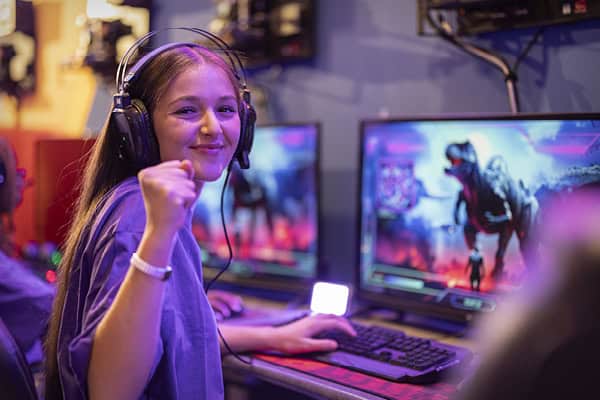Playing video games is a huge part of daily teen life, and more schools are using gaming to reach disengaged students, according to Education Week.
The vast majority (85 percent) of teens in the United States play video games, with 4 in 10 saying they play them at least once a day, according to a nationally representative Pew Research Center survey of 1,423 teens ages 13-17 conducted Sept. 26 to Oct. 23, 2023.
Meanwhile, esports, in which people play video games competitively on teams, is gaining a greater foothold in K-12 schools. The National Federation of State High School Associations, which has been conducting its High School Athletics Participation Survey since 1971, captured esports participation data for the first time in its 2022-23 survey. It found that 20,001 boys and 3,921 girls participated in esports during that school year.
The Grapevine-Colleyville district in Texas established its esports program in 2018 in response to the growing gaming industry and the rising popularity of collegiate esports, says Kyle Berger, the district’s chief technology officer.
The district wanted its esports program to be “more than just playing a game,” Berger says. So the district developed a curriculum to go along with the after-school esports clubs and teams.
The esports class is an elective for middle and high school students in the district that teaches them how digital sports work and what the industry looks like, Berger says. For instance, an esports team has many parts: players, technical support, marketing, those who broadcast the event, and those who do an analytical review of the gameplay. This means a student who enrolls in an esports class, or even participates after school, can take on any of these roles.
Students who participate on esports teams typically meet after school to practice and prepare for competitions statewide and even nationwide. And through esports, kids learn a lot of soft skills, such as communication and collaboration, Berger says.
Survey data from the Grapevine-Colleyville district show that 70 percent of the students now participating in esports had not been involved in any other school activity.
After school building shutdowns in the early days of the pandemic, the Moreno Valley district in California turned to scholastic esports as a way to reengage students, not just for academics but also for social development. Moreno Valley students can also take an esports class and/or participate in after-school esports clubs or teams.
“Taking something that [students] love—video games—and putting them in a classroom with like-minded peers and a caring adult is a game changer when it comes to not just camaraderie and collaboration and teamwork, but also a reduction in toxicity,” says Peter Whitmore, the esports coordinator for the Moreno Valley district.
Laurie Lehman, the esports project manager for the Albuquerque schools in New Mexico, says she also found esports was “a way to reach students that you couldn’t reach any other way.”
Albuquerque’s survey data show that 55 percent of students now involved in esports had not been involved in other extracurricular activities. For Moreno Valley, it’s 60 percent.
One of the biggest challenges is the cost of an esports program, according to district leaders.
Gaming requires stronger computers and monitors; other parts of an esports program (such as marketing and live-streaming) also require more equipment; and districts’ networks will need to be reprogrammed to allow gaming.
Berger says one solution is to leverage the computers and other equipment that districts already provide for their career and technical education classes.
Another challenge is finding staff to coach the esports teams or to sponsor the after-school clubs, district leaders say. One coach recruiting solution that the Moreno Valley district is using is to provide stipends for coaches.
Districts also must combat misconceptions about video games, district leaders say. There have been studies that link gaming to addictive and sometimes aggressive behaviors, but there are also studies that link gaming with better cognitive skills. In K-12 scholastic esports, students play age-appropriate multiplayer games, such as League of Legends, Rocket League, and Super Smash Bros that don’t feature violence. Coaches also train students to have good sportsmanship.
Districts that have esports programs say the benefits outweigh the costs.
Education Week





